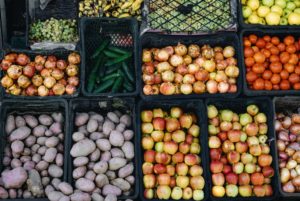When we try to forecast our preferences going forward, we often get it wrong. It’s a bias we all share called Naïve Diversification Bias. It happens a lot when we are making decisions now about some form of future consumption, and it can lead to feelings of dissatisfaction with our purchases.
 Naïve Diversification bias happens a lot at the supermarket. For example, have you ever bought a variety of snack packs of chips only to realize that everyone wants the same kind? Maybe you purchased an assortment of yogurt flavors at the store and then threw them out after they expire because you never ate the key lime ones you were sure you wanted to try? I have too. We all do this stuff because of the natural bias we all have for overestimating our preference for variety—and your customers also have it.
Naïve Diversification bias happens a lot at the supermarket. For example, have you ever bought a variety of snack packs of chips only to realize that everyone wants the same kind? Maybe you purchased an assortment of yogurt flavors at the store and then threw them out after they expire because you never ate the key lime ones you were sure you wanted to try? I have too. We all do this stuff because of the natural bias we all have for overestimating our preference for variety—and your customers also have it.
It doesn’t only happen at the grocery store. As I look at my bookshelf, I see some books I bought because I thought I should read them. I call them aspirational books. However, I haven’t read them. I also subscribe to a list of podcasts. I listen to five or six of them, but I will never get to the fifteenth. Nonetheless, I continue to subscribe…because maybe I’ll listen to it next week.
(By the way, my podcast is The Intuitive Customer, and you can subscribe to it – I hope you listen to it, too)
In reality, we are not as interested in variety as we thought.
As we discussed in a recent podcast, there are many reasons in the Behavioral Sciences for why this stuff happens. However, Naïve Diversification Bias is a significant driver of these particular forecasting errors. Some of it aspirational, meaning we think we should try new things. Sometimes we do it because we anticipate a need for variety, like with the yogurt flavors. In reality, we are not as interested in variety as we thought.
 Itamar Simonson, PhD, The Sebastian S. Kresge Professor of Marketing at Stanford University, is one of the more influential researchers in this area of the behavioral sciences. In a paper published in 1990, he demonstrated how we choose more variety for the future than when we choose for the moment. Professor Simonson brought snacks to the students every week for three weeks. He had them choose ahead of time what the students wanted as a snack from a list of options for one group. In another group, the students chose the snack each week. For both groups, everybody made three snack choices over three weeks and consumed them one per week. The only difference was when the students made their decisions about what to choose. Professor Simonson found that when people were deciding for the next three weeks combined, the students chose more variety, but when people were selecting each week, students would go for the same snack. It showed that “at the point of consumption,” students knew what they wanted—and it was their favorite snack.
Itamar Simonson, PhD, The Sebastian S. Kresge Professor of Marketing at Stanford University, is one of the more influential researchers in this area of the behavioral sciences. In a paper published in 1990, he demonstrated how we choose more variety for the future than when we choose for the moment. Professor Simonson brought snacks to the students every week for three weeks. He had them choose ahead of time what the students wanted as a snack from a list of options for one group. In another group, the students chose the snack each week. For both groups, everybody made three snack choices over three weeks and consumed them one per week. The only difference was when the students made their decisions about what to choose. Professor Simonson found that when people were deciding for the next three weeks combined, the students chose more variety, but when people were selecting each week, students would go for the same snack. It showed that “at the point of consumption,” students knew what they wanted—and it was their favorite snack.
I have seen this effect at work in a trip I take with friends. There are 12 of us that travel together (you know, back when that was something one did), and when we would book at restaurants, the establishment will sometimes ask us to order ahead of time. I was organizing one of these meals when it was my turn, and it nearly drove me round the bloody bend! Everyone would choose what they wanted and then, as the day approached, would change their orders.
 Of course, I am no different. I use a service called Graze. It’s a mail-order subscription service where they send you little snacks each week, mostly healthy stuff. Although I chose my snacks ahead of time, I now have a cupboard full of dried fruit that I didn’t eat. Why? When I was ordering, I thought eating dried fruit would be good for me, but when push comes to shove, and it’s time to snack, I don’t eat it.
Of course, I am no different. I use a service called Graze. It’s a mail-order subscription service where they send you little snacks each week, mostly healthy stuff. Although I chose my snacks ahead of time, I now have a cupboard full of dried fruit that I didn’t eat. Why? When I was ordering, I thought eating dried fruit would be good for me, but when push comes to shove, and it’s time to snack, I don’t eat it.
When you give customers choices that look into the future, they will do the same. Customers look into the future, anticipate a desire for variety, and then don’t want the variety once it comes.
So, does that mean people don’t want a variety of choices? The answer is complicated. People want options, yes, but having choices does not improve their experience as much as customers think it will. Moreover, too many choices can cause problems, including Naïve Diversification. Too much variety can also cause confusion, frustration, and loss of motivation. However, if you ask customers, they will tell you they want more choices. After customers find themselves in a situation where they have too many options, customers are surprised that it’s challenging for them.
I’m not too fond of too many choices. For example, when I go on Amazon and put in a search, I rarely go to the second page. However, there are multitudinous pages of products on Amazon to choose from, which is, in part, what drew me to Amazon in the first place. However, Amazon customers rarely scroll past the second page. One way Amazon shoppers respond is by using filters or sorting by different criteria. “Average customer reviews” is one I use a lot. The more the reviews there are, the better. Another one I use is “verified purchase.” With this strategy, it feels like there are many choices, but then I can narrow and prioritize the field of options by inputting specific criteria.
Another good strategy for avoiding the Naïve Diversification bias is to make choices as close to the moment of consumption as possible. For instance, I should re-examine my Graze order. At a certain point, I will realize how much money I am wasting on dried fruit I don’t eat, which will lead to my canceling my subscription. However, if Graze sent me a prompt to refresh my preferences, I could revise my list and pick the stuff I want and feel good about keeping my subscription. So, if organizations can decrease the time between choice and consumption, then people will make improved forecasting decisions.
 Finally, understanding how these feelings of dissatisfaction affect customer behavior is essential. We know that many organizations have customer journey maps prepared, which is excellent for showing you a process. However, it does not show you customer behavior. Moreover, COVID-19 has changed your customers’ journeys. People are buying differently, which means that Customers will now have a new process. It is essential to know what these are and to understand their behavior along the way. Behavioral Journey Mapping takes this exercise a step further by charting customer behavior throughout the process. In essence, it is showing you how your experience affects what your customers do.
Finally, understanding how these feelings of dissatisfaction affect customer behavior is essential. We know that many organizations have customer journey maps prepared, which is excellent for showing you a process. However, it does not show you customer behavior. Moreover, COVID-19 has changed your customers’ journeys. People are buying differently, which means that Customers will now have a new process. It is essential to know what these are and to understand their behavior along the way. Behavioral Journey Mapping takes this exercise a step further by charting customer behavior throughout the process. In essence, it is showing you how your experience affects what your customers do.
So, what should you do with this information?
- Recognize Naïve Diversification Bias. First, I recommend recognizing the Naïve Diversification Bias when people make choices for future consumption. These choices will be different than what people choose for immediate consumption. If you are in a situation where the bias can come into play, acknowledge that it is a potential source of customer dissatisfaction.
- Understand that people change their minds. Know that customers will have dissatisfied feelings regarding their forecasting errors, i.e., my cupboard full of dried fruit. It is essential to identify these moments and find ways to mitigate these by customer communication and opportunities to make changes. We recommend discovering this by mapping behavior rather than only the customer process.
- Develop strategies around the negatives of the bias. Offer customers opportunities to send stuff back or re-evaluate their subscribed choices periodically.
- Compress the time between choice and consumption as much as possible. People make much better choices for what they want at the moment than they do in a projected time frame. Whenever possible, give them a shorter interval or allow for individual decisions rather than a “set” to decrease the opportunity to forecast errors on behalf of their future selves.
- Build filtered-diversification into your offer. When the choice is for future consumption, it would be best to have a variety of options, but also a way to narrow down choices based on customer-driven criteria. So, as I said about Amazon, it’s great to have several pages of options but help customers by allowing them to filter by criteria, so the best recommendations are on pages one or two. Having various options presented satisfies the psychological need for choice, but the filter helps to prevent overwhelming customers with options and lose them in the process.
Naïve Diversification bias is a common trait we share. We aren’t always great about knowing what we will want in the future, and neither are your customers. It can lead to less than optimal outcomes with experiences, and customer feelings about your experience that are less than optimal, too, and the kind that does not lead to customer-driven growth.
However, suppose we recognize our tendency to overestimate our preference for variety in the future and minimize the opportunity to make forecasting errors for our customers. In that case, you can mitigate the consequences of customers’ actions that can lead to their choosing a variety of providers for your product and service in the future.
To hear more about this idea in more detail, listen to the complete podcast here.
Colin Shaw is the founder and CEO of Beyond Philosophy, one of the world’s leading Customer experience consultancy & training organizations. Colin is an international author of six bestselling books and an engaging keynote speaker.
Follow Colin Shaw on Twitter @ColinShaw_CX

